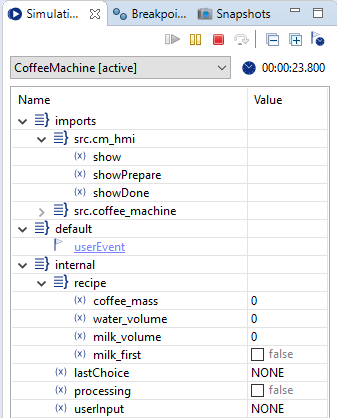Table of contents
YAKINDU Statechart Tools 3.2.0 (Jan 11, 2018) Copy link to clipboard
For this release, the YAKINDU Statechart Tools team fixed 66 Standard Edition and 28 Professional Edition issues. Apart from several bug fixes, we added some great new features:
- Pinned diagram editor: The editor for the statechart definition section can be pinned and collapsed now.
- Reworked simulation view: Better support for working with parallel simulation sessions and time triggers.
- Statechart image generator: Automatically export raster or SVG images for statechart models and subdiagrams.
- Built-in variables for the generator model: Built-in variables like USER, SCTVERSION and TIMESTAMP can be used in the generator model.
- C++ domain (beta): First beta release of deep C++ integration is available. C++ headers can be accessed from the statechart model now.
We also changed the license management for this release. After 30 days of trial you need a valid license file for non-commercial use now. YAKINDU Statechart Tools still is and always be free of charge for non-commercial and academic use. You can apply for a non commercial license here:
https://info.itemis.com/yakindu/statecharts/non-commercial/order/
Pinned diagram editor Copy link to clipboard
By default, a statechart’s definition section is positioned at the left-hand side of the canvas, and it is part of the diagram. Now the definition section comes with an option to pin it to the left-hand side of the view. In order to pin the definition section, you simply click on the small decorator icon in the upper-left corner of the area. This feature has to be enabled first via Window / Preferences / YAKINDU Statechart Tools / Diagram Appearance / Enable pinning of definition section.
New Simulation view Copy link to clipboard
We completely reworked the Simulation view to ease working with parallel simulation sessions. The Simulation view now provides a drop-down box that lists all running sessions. Resume, Pause, Stop and Single step actions can be accessed directly from the view. Furthermore, the current simulation time is now shown. This is especially useful when working with time triggers.

Built-in variables for the generator model Copy link to clipboard
With the October release 3.1.0 we introduced properties and expressions for the generator model . We extended this feature in the current version with a set of meaningful built-in properties that can be used within expressions:
- SCTVERSION: Returns the current version of YAKINDU Statechart Tools
- TIMESTAMP: Returns the current date and time as a localized string
- USER: Returns the name of the current user
- HOSTNAME: Returns the host name of the machine
These properties can be used within generator model expressions, for example, to add timestamp, user, and version to the license header in the generated code.
feature LicenseHeader {
licenseText = "Generated on " + TIMESTAMP + " with YAKINDU Statechart Tools " + SCTVERSION
}
This feature produces the following output:
/* Generated on 11.12.2017 17:08:14 with YAKINDU Statechart Tools 3.2.0 */
C++ Domain (beta) Copy link to clipboard
This release contains the first version of the deep C++ integration feature. It is now possible to import C++ headers and use C++-specific language concepts directly from within a statechart model. Detailed documentation and examples will follow soon.
Miscellaneous improvements and bug fixes Copy link to clipboard
- Diagram syntax coloring can be activated via _Window / Preferences / YAKINDU Statechart Tools / Diagram Appearance / Syntax Coloring
- Updated documentation regarding the execution semantics of child-first/parent first and reactions
- Keyboard shortcut [Ctrl+0] resets the zoom factor
- Region priorities are now shown on the canvas
- The expression language now supports postfix increment and decrement operations
- Code generators check whether callback interfaces are set
- SCT is now fully compatible with Java 9